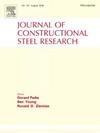Numerical analysis and experimental validation of new steel-stiffened hybrid steel-PFRP bolted joints
IF 4
2区 工程技术
Q1 CONSTRUCTION & BUILDING TECHNOLOGY
引用次数: 0
Abstract
A new hybrid steel-PFRP (Pultruded Fiber-Reinforced Polymer) bolted joint stiffened by steel plates is proposed in this paper to improve the joint efficiency for hybrid steel-PFRP lattice structures. The performance of the new steel-stiffened hybrid steel-PFRP joint (SHJ) was investigated and compared with that of ordinary steel-PFRP bolted joint (OBJ) using finite element method (FEM) and experimental test. In the numerical simulations, three-dimensional (3D) progressive damage joint models were developed and validated by joint tests, in which damage was investigated by employing Hashin failure criterion for PFRP part. Moreover, full-scale structural tests were also performed to further calibrate the performance of SHJ and OBJ in hybrid steel-PFRP lattice structures. The results from both joint level and structure level indicate that the performance of SHJ including ultimate bearing capacity, stiffness and joint efficiency is prominently superior to that of OBJ. SHJ is feasible and effective for application in hybrid steel-PFRP lattice structures. Parametric studies on SHJ were further conducted. The influences of the geometric parameters, such as the end distance to bolt diameter ratio (e/d) and the PFRP width to bolt diameter ratio (w/d), on the failure mode of SHJ were also discussed with the validated 3D progressive damage models.
新型钢加固混合钢-PFRP 螺栓连接的数值分析和实验验证
本文提出了一种由钢板加固的新型钢-PFRP(拉挤纤维增强聚合物)混合螺栓连接,以提高钢-PFRP 混合晶格结构的连接效率。本文采用有限元法(FEM)和实验测试研究了新型钢加固混合钢-PFRP 连接(SHJ)的性能,并与普通钢-PFRP 螺栓连接(OBJ)的性能进行了比较。在数值模拟中,建立了三维(3D)渐进损伤接头模型,并通过接头试验进行了验证,其中采用 Hashin 失效准则对 PFRP 部分的损伤进行了研究。此外,还进行了全尺寸结构试验,以进一步校准 SHJ 和 OBJ 在钢-PFRP 混合晶格结构中的性能。连接层面和结构层面的结果表明,SHJ 的性能(包括极限承载能力、刚度和连接效率)明显优于 OBJ。SHJ 在钢-PFRP 混合网格结构中的应用是可行且有效的。对 SHJ 进一步进行了参数研究。此外,还利用经过验证的三维渐进破坏模型讨论了端距与螺栓直径比(e/d)和 PFRP 宽度与螺栓直径比(w/d)等几何参数对 SHJ 失效模式的影响。
本文章由计算机程序翻译,如有差异,请以英文原文为准。
求助全文
约1分钟内获得全文
求助全文
来源期刊

Journal of Constructional Steel Research
工程技术-工程:土木
CiteScore
7.90
自引率
19.50%
发文量
550
审稿时长
46 days
期刊介绍:
The Journal of Constructional Steel Research provides an international forum for the presentation and discussion of the latest developments in structural steel research and their applications. It is aimed not only at researchers but also at those likely to be most affected by research results, i.e. designers and fabricators. Original papers of a high standard dealing with all aspects of steel research including theoretical and experimental research on elements, assemblages, connection and material properties are considered for publication.
 求助内容:
求助内容: 应助结果提醒方式:
应助结果提醒方式:


